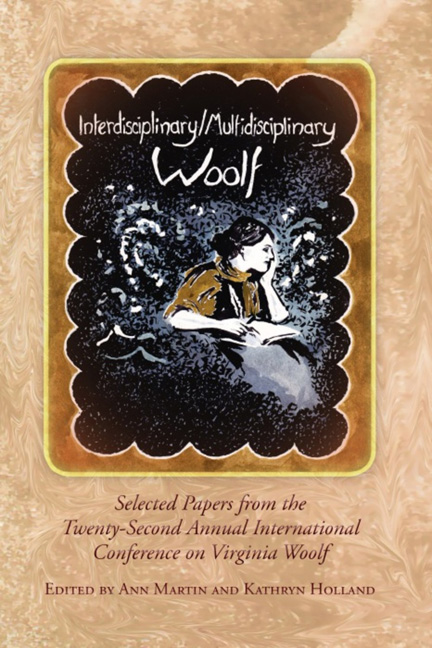Book contents
- Frontmatter
- Contents
- Introduction to Interdisciplinary/Multidisciplinary Woolf
- Acknowledgments
- List of Abbreviations
- History, Materiality, Multiplicity
- Patterns, Practices, Principles
- Art, Influence, Embodiment
- “Time has whizzed back an inch or two on its reel”: Relating Virginia Woolf and Emily Carr through Vintage Postcards, Lily Broscoe, Mrs. McNab, and the Cinematic Time of To the Lighthouse
- Speaking Citizen to Citizen in a Time of War: Miss La Trobe's Use of Parabasis in her Historical Pageant
- Work as Salvation: Eureka's Angel in the House, A Dircetor's Experience
- Drawing as Thinking: A Visual Response to To the Lighthouse
- Performing Feminism, Transmitting Affect: Isadora Duncan, Virginia Woolf, and the Politics of Movement
- Virginia Woolf and Clarice Lispector: Thinking Back Through Brazilian Mothers
- Mystical Gibberish or Renegade Discourse?: Poetic Language According to Orlando
- Selves and Others as Narrative Participants in Woolf's Novels
- Publishing, Politics, Publics
- Notes on Contributors
- Conference Program
Performing Feminism, Transmitting Affect: Isadora Duncan, Virginia Woolf, and the Politics of Movement
from Art, Influence, Embodiment
- Frontmatter
- Contents
- Introduction to Interdisciplinary/Multidisciplinary Woolf
- Acknowledgments
- List of Abbreviations
- History, Materiality, Multiplicity
- Patterns, Practices, Principles
- Art, Influence, Embodiment
- “Time has whizzed back an inch or two on its reel”: Relating Virginia Woolf and Emily Carr through Vintage Postcards, Lily Broscoe, Mrs. McNab, and the Cinematic Time of To the Lighthouse
- Speaking Citizen to Citizen in a Time of War: Miss La Trobe's Use of Parabasis in her Historical Pageant
- Work as Salvation: Eureka's Angel in the House, A Dircetor's Experience
- Drawing as Thinking: A Visual Response to To the Lighthouse
- Performing Feminism, Transmitting Affect: Isadora Duncan, Virginia Woolf, and the Politics of Movement
- Virginia Woolf and Clarice Lispector: Thinking Back Through Brazilian Mothers
- Mystical Gibberish or Renegade Discourse?: Poetic Language According to Orlando
- Selves and Others as Narrative Participants in Woolf's Novels
- Publishing, Politics, Publics
- Notes on Contributors
- Conference Program
Summary
In her autobiography, My Life, published posthumously in 1927, Isadora Duncan tries to communicate with words the dance she feels forming in her body as she studies the Bacchanal from Wagner's Tannhäuser: “ I am only able to give you a vague indication,… of what most dancers will be later on—masses rushing like whirlwinds in rhythms caught up by mad waves of this music, flowing with fantastic sensuality and ecstasy…Can all this be expressed?…[C]an [these visions] be clothed in a manifested form? Why try this impossible effort? I repeat, I do not fulfill it, I only indicate” (144). Duncan's preference for an art form that indicates and moves, rather than one that represents and stills, finds an echo in Virginia Woolf's account of the arduous process that was writing The Waves : “[ideas] flaunt and fly like the shadows over the downs…I think then that my difficulty is that I am writing to a rhythm and not to a plot. Does this convey anything?” (L4 204). As was true for Duncan, rhythm for Woolf is “very profound, and goes far deeper than words” (204). In order to plumb these depths, Woolf recognizes that her images must “never work out; only suggest” (D4 4) and that she must “break up, dig deep, make prose move—yes I swear—as prose has never moved before” (11).
Modern dance and dancers, Isadora Duncan in particular, have received renewed attention in Modernist literary studies as of late, most notably in Carrie Preston's Modernism's Mythic Pose: Gender, Genre, Solo Performance (2011). Regarding Woolf studies, scholars like Susan Jones and Evelyn Haller have contextualized Woolf's fiction in relation to Diaghilev's Ballet Russes or Japanese Noh, while Rishona Zimring has discussed how social dance signifies the precariousness of collective and communal values in Woolf's work. However, there have been no considerations of Woolf's oeuvre in relation either to Isadora Duncan's dance or her theory thereof as espoused in her autobiography My Life and other essays. This may be explained, as Zimring notes, by the fact that for Woolf and Bloomsbury the Russian Ballet was far more significant due to its frequent London performances, whereas the American female soloists, like Loie Fuller and Isadora Duncan, were simply not part of the regular theatre-going experience for Londoners (711).
- Type
- Chapter
- Information
- Interdisciplinary/Multidisciplinary Woolf , pp. 183 - 189Publisher: Liverpool University PressPrint publication year: 2013



